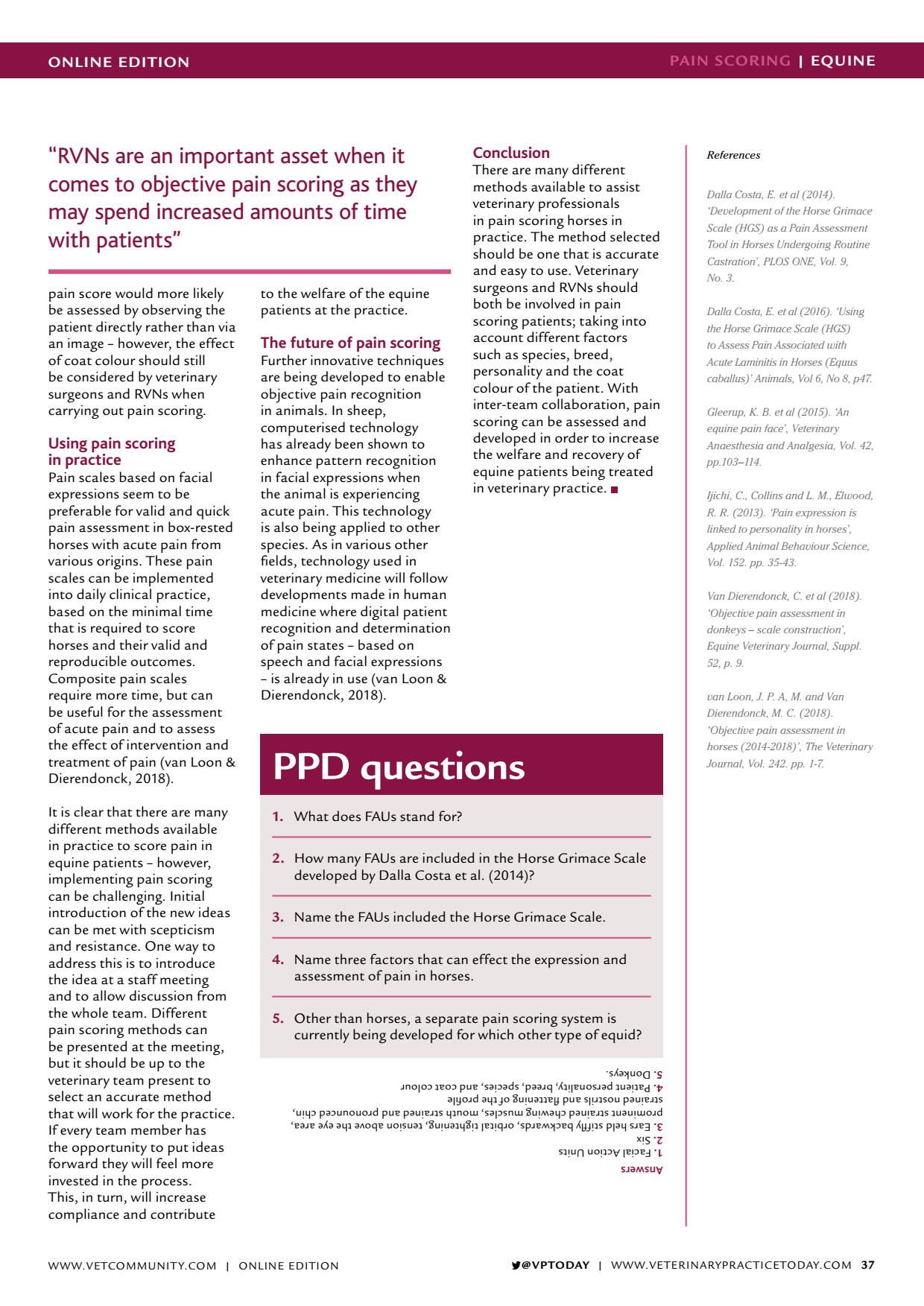questions Using pain
ONLINE EDITION PAIN SCORING | EQUINE VPTODAY | WWW.VETERINARYPRACTICETODAY.COM 37 References Dalla Costa, E. et al (2014). Development of the Horse Grimace Scale (HGS) as a Pain Assessment Tool in Horses Undergoing Routine Castration, PLOS ONE, Vol. 9, No. 3. Dalla Costa, E. et al (2016). Using the Horse Grimace Scale (HGS) to Assess Pain Associated with Acute Laminitis in Horses (Equus caballus) Animals, Vol 6, No 8, p47. Gleerup, K. B. et al (2015). An equine pain face, Veterinary Anaesthesia and Analgesia, Vol. 42, pp.103114. Ijichi, C., Collins and L. M., Elwood, R. R. (2013). Pain expression is linked to personality in horses, Applied Animal Behaviour Science, Vol. 152. pp. 35-43. Van Dierendonck, C. et al (2018). Objective pain assessment in donkeys scale construction, Equine Veterinary Journal, Suppl. 52, p. 9. van Loon, J. P. A, M. and Van Dierendonck, M. C. (2018). Objective pain assessment in horses (2014-2018), The Veterinary Journal, Vol. 242. pp. 1-7. PPD questions 1. What does FAUs stand for? 2. How many FAUs are included in the Horse Grimace Scale developed by Dalla Costa et al. (2014)? 3. Name the FAUs included the Horse Grimace Scale. 4. Name three factors that can effect the expression and assessment of pain in horses. 5. Other than horses, a separate pain scoring system is currently being developed for which other type of equid? Answers 1. Facial Action Units 2. Six 3. Ears held stiffly backwards, orbital tightening, tension above the eye area, prominent strained chewing muscles, mouth strained and pronounced chin, strained nostrils and flattening of the profile 4. Patient personality, breed, species, and coat colour 5. Donkeys. pain score would more likely be assessed by observing the patient directly rather than via an image however, the effect of coat colour should still be considered by veterinary surgeons and RVNs when carrying out pain scoring. Using pain scoring in practice Pain scales based on facial expressions seem to be preferable for valid and quick pain assessment in box-rested horses with acute pain from various origins. These pain scales can be implemented into daily clinical practice, based on the minimal time that is required to score horses and their valid and reproducible outcomes. Composite pain scales require more time, but can be useful for the assessment of acute pain and to assess the effect of intervention and treatment of pain (van Loon & Dierendonck, 2018). It is clear that there are many different methods available in practice to score pain in equine patients however, implementing pain scoring can be challenging. Initial introduction of the new ideas can be met with scepticism and resistance. One way to address this is to introduce the idea at a staff meeting and to allow discussion from the whole team. Different pain scoring methods can be presented at the meeting, but it should be up to the veterinary team present to select an accurate method that will work for the practice. If every team member has the opportunity to put ideas forward they will feel more invested in the process. This, in turn, will increase compliance and contribute to the welfare of the equine patients at the practice. The future of pain scoring Further innovative techniques are being developed to enable objective pain recognition in animals. In sheep, computerised technology has already been shown to enhance pattern recognition in facial expressions when the animal is experiencing acute pain. This technology is also being applied to other species. As in various other fields, technology used in veterinary medicine will follow developments made in human medicine where digital patient recognition and determination of pain states based on speech and facial expressions is already in use (van Loon & Dierendonck, 2018). Conclusion There are many different methods available to assist veterinary professionals in pain scoring horses in practice. The method selected should be one that is accurate and easy to use. Veterinary surgeons and RVNs should both be involved in pain scoring patients; taking into account different factors such as species, breed, personality and the coat colour of the patient. With inter-team collaboration, pain scoring can be assessed and developed in order to increase the welfare and recovery of equine patients being treated in veterinary practice. RVNs are an important asset when it comes to objective pain scoring as they may spend increased amounts of time with patients WWW.VETCOMMUNIT Y.COM | ONLINE EDITION
